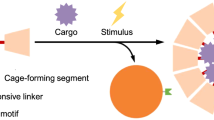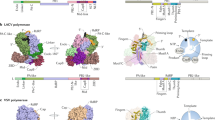Abstract
THE genome of measles virus, a paramyxovirus, is a non-segmented single stranded RNA molecule which is enclosed within a helix of protein subunits to form a linear nucleocapsid1. Little is known about its mode of replication. It is known, however, for other paramyxoviruses that during the growth cycle transcription of the RNA occurs from an intact nucleocapsid by a virion-associated enzyme2–4. The resulting messenger RNA molecules are less than the full genome length and are unencapsidated5. By contrast, during viral RNA replication no free genome length RNA can be detected5,6 and both plus and minus-stranded RNA are found only in the encapsidated form7. From this evidence, Kingsbury has suggested7 that nucleocapsids of paramyxoviruses replicate without separation of the protein and nucleic acid portions of the template nucleocapsid and has implied that plus and minus-stranded RNAs enclosed within the capsid structure act as templates for each other. If this is so, association of the two types of nucleocapsid in a replicative form should be detectable in infected cells. We have conducted a search by electron microscopy for such structures in measles virus infected cells and the results are described here.
This is a preview of subscription content, access via your institution
Access options
Subscribe to this journal
Receive 51 print issues and online access
$199.00 per year
only $3.90 per issue
Buy this article
- Purchase on SpringerLink
- Instant access to full article PDF
Prices may be subject to local taxes which are calculated during checkout
Similar content being viewed by others
References
Finch, J. T. & Gibbs, A. J. J. gen. Virol. 6, 141–150 (1970).
Huang, A. S., Baltimore, D. & Bratt, M. A. J. Virol. 7, 389–394 (1971).
Robinson, W. S. J. Virol 8, 81–86 (1971).
Stone, H. O., Portner, A. & Kingsbury, D. W. J. Virol. 8, 174–180 (1971).
Blair, C. D. & Robinson, W. S. J. Virol 5, 639–650 (1970).
Robinson, W. S. Virology 44, 494–502 (1971).
Kingsbury, D. W. Med. microbiol. Immunol 160, 73–83 (1974).
Shirodaria, P. V., Dermott, E. & Gould, E. A. J. gen. Virol. 33, 107–115 (1976).
Thorne, H. V. & Dermott, E. Nature 264, 473–474 (1976).
Compans, R. W. & Choppin, P. W. Virology 33, 344–346 (1967).
Author information
Authors and Affiliations
Rights and permissions
About this article
Cite this article
THORNE, H., DERMOTT, E. Y-forms as possible intermediates in the replication of measles virus nucleocapsids. Nature 268, 345–347 (1977). https://doi.org/10.1038/268345a0
Received:
Accepted:
Issue date:
DOI: https://doi.org/10.1038/268345a0



